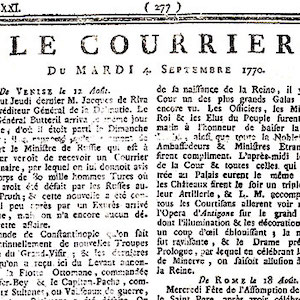Revolutions

National Security Archive: Sources on Europe
These materials help students discover that history does not follow a predetermined course, but is the result of decisions, any one of which could drastically alter history’s outcome.
Excerpt from Courrier of Avignon
This paper is from September 1770 and at that time France had two kinds of newspapers, those run by the state that were censored and also papers published beyond the borders of France that had licenses to get in but could that be they could be revoked at any time.

Fine Arts in Hungary
A handy feature of this site is the Guided Tours, designed to help users 'discover the territory of Hungarian fine arts.'
South Texas Border, 1900-1920: Photographs from the Robert Runyon Collection
These images represent a valuable visual record of life in the south Texas borderlands during the 1910s and 1920s, as well as an important window onto a relatively understudied phase of the Mexican Revolution.U.S. Plans to Influence Bulgarian Political Changes
On November 10, 1989, the day after the fall of the Berlin Wall, leading figures in the Bulgarian Communist Party (BCP) forced Todor Zhivkov, Bulgaria’s leader for more than 35 years, to resign.
U.S. Reaction to Romanian Violence
In this December 18 communique from the U.S.
Official Romanian Version of December Events
This telegram from the Romanian Ministry of Foreign Affairs, sent on December 19, comes two days after the shooting of demonstrators in Timisoara and informs Romanian ambassadors abroad of the government's official position on the crisis and how they should handle questions from their foreign hos
Breakdowns in Soviet-Romanian Relations
In its final years, Nicolae Ceausescu's dictatorial regime in Romania increasingly isolated itself from the rest of the Eastern Bloc. Likewise, Soviet leader Mikhail Gorbachev distanced himself from the ultra-hardliners in Bucharest.
The Possible Soviet Intervention in Romania
Romanian security forces' violent assault on demonstrators in Timisoara in mid-December 1989 sparked a wave of speculation as to whether this spelled the end of Nicolae Ceausescu, the region's sole remaining communist dictator.
Romanian Assessment of Recent Events in Eastern Europe
In this December 22 telegram, Romanian ambassador to Moscow Ion Bucur reported to Deputy Foreign Minister Constantin Oancea in Bucharest on his discussions with Soviet officials concerning the situation in Eastern Europe, particularly the backlash against communist authorities.